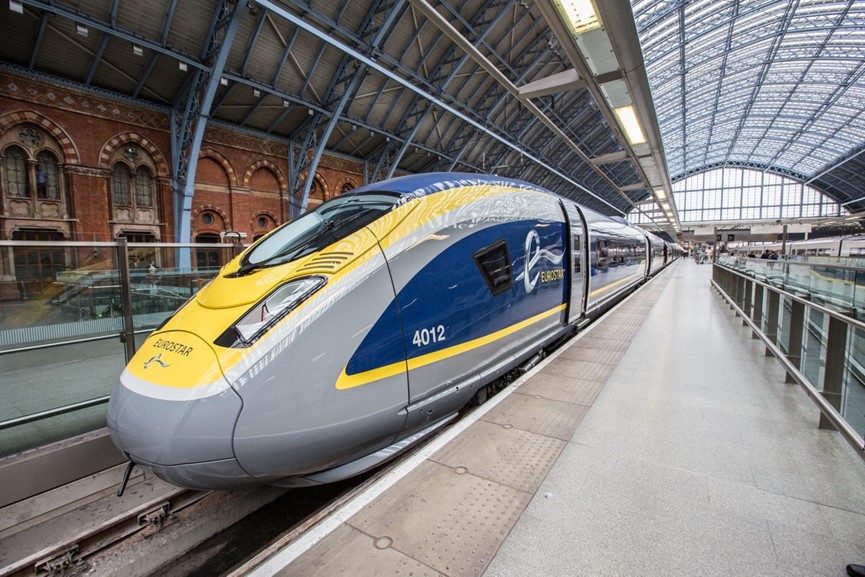How to save money on traveling by train in Europe.

Train travel in Europe is often romanticized—bygone youthful days backpacking with a Eurail Pass, stunning views of the Alps, and lots of legroom. And it’s true that many train routes in Europe offer perks like iconic vistas, much more personal space than an economy flight, fewer strict luggage requirements, and a reasonably pleasant way to get from A to B that doesn’t involve busy airports or lost luggage.
European train travel also has its cons. It can be expensive, and navigating national train websites and organizing the right routes isn’t always easy. But there are ways to make train travel throughout Europe an affordable, positive experience. Armed with these tips, you can happily ride the rails through Europe without overspending.
Skip first class.
Even the lowest train classes in Europe are still pretty comfortable. If you’re on a budget, skip first class and go second. You’ll probably still have a fairly pleasant experience and save money at the same time.
Take slower trains.
High-speed trains are fast but can often be more expensive. Sometimes the “slow” train isn’t that much slower but may save you a significant amount of money.
Base yourself in an affordable city.
Sometimes establishing a base in an affordable city allows you to take shorter, regional, and budget-friendly train trips without overspending on accommodation. For example, staying a few nights in Madrid and taking day trips via train to Segovia, Toledo, or Avila won’t set you back much. Likewise, visiting Breccia, Bergamo, and Lake Como from Milan by rail is reasonably affordable. Smaller cities also can be excellent bases for a budget traveler. For example, from Toulouse, you can take easy train trips to French villages like Castres or Albi.
Don’t discount Eastern Europe.
It’s easy to associate the rails with Eurostar or Deutsche Bahn, but trains are often extremely affordable in Eastern Europe. I’ve found tickets from Bratislava to Vienna for under €10 per way and for the seven-hour Budapest to Prague trip for less than €20.
Research rail passes.
While Eurail and Interrail passes can be good choices for those spending a few months in Europe or anyone who really wants to move around, they aren’t always the best deal, depending on your travel plans and goals. If you think these rail passes may be a good fit, do the research and compare pricing to make sure you get the most affordable option.
Book in advance.
In most cases, assuming you’re definite on your travel plans, booking in advance can save you money. If you already know you need to go from A to B on a certain date, book your ticket. Last-minute rail tickets, especially during peak dates or times, can be expensive or even sold out, depending on the route.
Consider overnight trains.
Even if an overnight train costs more than a daytime train or flight, don’t forget to factor in what you’ll save on not having to pay for a night of accommodation. Plus, such a trip can be a fun and novel experience, especially in a couchette or private sleeper cabin.
Travel off-peak.
Find the best train deals in winter, spring, and autumn outside of the big festivals and holidays. (Peak dates like Christmas and Easter are usually expensive times.) Routes are also important. Obviously, Switzerland’s Glacier Express is best taken in winter, but that’s when it is usually the most expensive. Taking it in the shoulder season can still offer snowy views at a more affordable price. The same goes with routes like Madrid to Mediterranean hubs such as Alicante or Valencia, which are often pricey in summer when everyone wants to escape the city and head to the beach. Consider taking these trains in the late spring or early autumn when they might be more affordable and you can still enjoy decent beach weather.
Compare the cost of a train to the cost of flying.
One of the most affordable train tips is to fly instead. That is, often flying a low-cost carrier like Ryanair or easyJet is cheaper than taking the train. Just make sure to take into account the extra time you’ll spend at the airport and the extra cost it takes to get from the airport to the city center when deciding whether to take the train or fly.
Luggage considerations are also important. If you have a few hold luggage bags, tacking this cost onto airfare may double the price of the ticket price, making the train a better deal.
Consider low-cost train carriers.
Certain countries such as Spain now offer low-cost train carriers. For example, a one-way ticket on Ouigo (a subset of the French SCNF) from Madrid to Valencia or Alicante can be as cheap as €9, whereas Renfe, Spain’s national rail operator, typically charges €35-€65 per way.
Don’t forget about youth, family, and senior discounts.
Many countries in Europe offer discounts for those under 26 and over 60. Family and group discounts vary by country and company but are often an option, too. Make sure to research these discounts before booking.
Book direct.
In most cases, it’s best to book train travel directly on the train carrier’s website to avoid additional charges and fees or having to deal with a third-party service in case of strikes or cancellations. Use a company like Trainline to search in order to compare prices, companies, and routes. But when it comes time to book, go to the train company’s website.
Be flexible.
Save money on train fares by being flexible with the date and time of travel. Similar to airfare, train prices can vary by date, month, or even time of day. Sometimes waking up early to get that first train or taking the last train of the day can save you money.
Watch out for station scams and pickpockets.
Even if you end up with a very affordable train ticket, getting pickpocketed at the train station or getting your card skimmed using the ticket machine can negate those savings. Stay aware of your belongings and presence (even if it’s just a front) to avoid being an easy target for pickpockets and scammers. Familiarizing yourself with the station map ahead of time and traveling light are ways to make the station experience easier. Buying tickets ahead of time online can help you avoid being the victim of fraud or skimming when using train station ticket machines.
Twist’s Take: Consider train travel as a fun and affordable alternative to flying when planning your travels around Europe.

